OverviewThe harmful use of alcohol is one of the leading risk factors for population health. It is linked with over 200 health conditions, including noncommunicable diseases (NCDs) and mental health conditions, maternal and child health, infectious diseases, and injuries. This psychoactive substance caused 5.5% of all deaths and 6.7% of all disability-adjusted life years in the Region of the Americas in 2016. It also causes a significant social burden and imposes substantial direct treatment costs and indirect economic costs that represent a serious threat to economic and social development. This impact is recognized by target 3.5 of the Sustainable Development Goals aiming to “strengthen the prevention and treatment of substance abuse, including narcotic drug abuse and harmful use of alcohol”. The amount and frequency of alcohol consumed by an individual is determined, in large part, by the affordability of alcoholic beverages. Such affordability depends on the real price of alcoholic beverages, the price of other goods and services, and consumers’ incomes. Thus, there is strong health and economic rationale for the use of fiscal policies targeting alcoholic beverages. The World Health Organization (WHO) recommends reducing the harmful use of alcohol through increased excise taxes on alcoholic beverages as part of the WHO Global strategy to reduce the harmful use of alcohol, and the Pan American Health Organization (PAHO) Plan of Action to Reduce the Harmful Use of Alcohol. It is also part of the WHO recommended most cost-effective, evidence-based policies to prevent and control NCDs, and it is highlighted as one of five high-impact strategies of the SAFER technical package. Although 33 out of the 35 PAHO Member States apply excise taxes on alcoholic beverages, there is great heterogeneity in their design and rates, and most could be further leveraged to improve their impact on alcohol consumption and health. PAHO is committed to providing Member States with accurate, relevant, and internationally comparable information that they can use to guide the development of policy and to evaluate the impact of measures to prevent the harmful use of alcohol. Developing a tax share indicator is necessary to monitor taxes on alcoholic beverages, enable standardized comparisons across countries and over time, establish best practices in tax design, and provide a powerful tool for advocacy. Since 2016, the Department of Noncommunicable Diseases and Mental Health (NMH) at PAHO has been working on developing standardized and comparable indicators of the share of indirect taxes in the price of alcoholic beverages. Building on this experience and the WHO methodology for monitoring tobacco taxes, this brochure presents the results of pioneering tax share and complementary price and tax policy indicators for alcoholic beverages—including beer, wine, and spirits—in 30 PAHO Member States. This brochure is a tool for data dissemination to the different sectors involved in alcohol taxation in the Region of the Americas and, likewise, to help countries in designing, planning, and evaluating alcohol taxes to reduce the harmful use of alcohol. |

